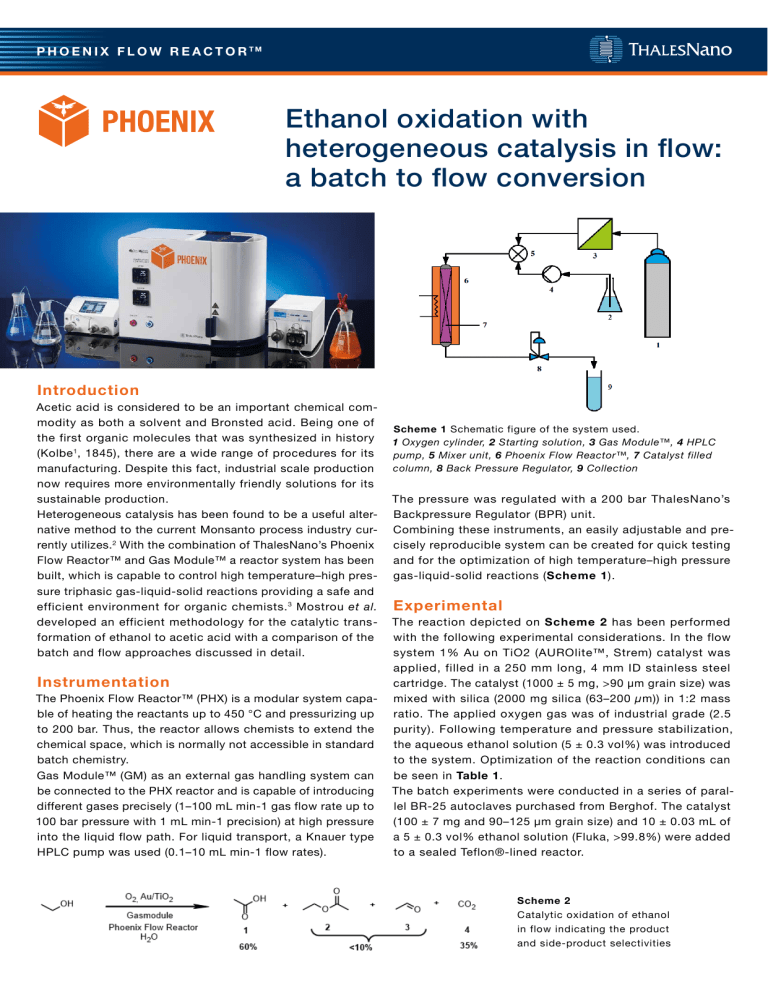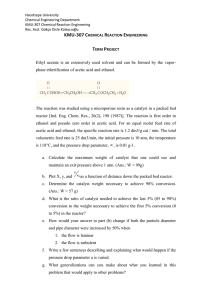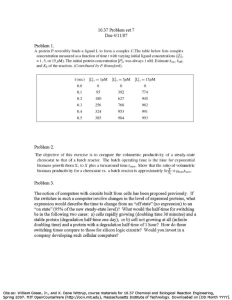
P h o e n i x F l o w R e a c t o r TM Ethanol oxidation with heterogeneous catalysis in flow: a batch to flow conversion Introduction Acetic acid is considered to be an important chemical commodity as both a solvent and Bronsted acid. Being one of the first organic molecules that was synthesized in history (Kolbe 1, 1845), there are a wide range of procedures for its manufacturing. Despite this fact, industrial scale production now requires more environmentally friendly solutions for its sustainable production. Heterogeneous catalysis has been found to be a useful alternative method to the current Monsanto process industry currently utilizes.2 With the combination of ThalesNano’s Phoenix Flow Reactor™ and Gas Module™ a reactor system has been built, which is capable to control high temperature–high pressure triphasic gas-liquid-solid reactions providing a safe and efficient environment for organic chemists. 3 Mostrou et al. developed an efficient methodology for the catalytic transformation of ethanol to acetic acid with a comparison of the batch and flow approaches discussed in detail. Instrumentation The Phoenix Flow Reactor™ (PHX) is a modular system capable of heating the reactants up to 450 °C and pressurizing up to 200 bar. Thus, the reactor allows chemists to extend the chemical space, which is normally not accessible in standard batch chemistry. Gas Module™ (GM) as an external gas handling system can be connected to the PHX reactor and is capable of introducing different gases precisely (1–100 mL min-1 gas flow rate up to 100 bar pressure with 1 mL min-1 precision) at high pressure into the liquid flow path. For liquid transport, a Knauer type HPLC pump was used (0.1–10 mL min-1 flow rates). Scheme 1 Schematic figure of the system used. 1 Oxygen cylinder, 2 Starting solution, 3 Gas Module™, 4 HPLC pump, 5 Mixer unit, 6 Phoenix Flow Reactor™, 7 Catalyst filled column, 8 Back Pressure Regulator, 9 Collection The pressure was regulated with a 200 bar ThalesNano’s Backpressure Regulator (BPR) unit. Combining these instruments, an easily adjustable and precisely reproducible system can be created for quick testing and for the optimization of high temperature–high pressure gas-liquid-solid reactions (Scheme 1). Experimental The reaction depicted on Scheme 2 has been performed with the following experimental considerations. In the flow system 1% Au on TiO2 (AUROlite™, Strem) catalyst was applied, filled in a 250 mm long, 4 mm ID stainless steel cartridge. The catalyst (1000 ± 5 mg, >90 μm grain size) was mixed with silica (2000 mg silica (63–200 µm)) in 1:2 mass ratio. The applied oxygen gas was of industrial grade (2.5 purity). Following temperature and pressure stabilization, the aqueous ethanol solution (5 ± 0.3 vol%) was introduced to the system. Optimization of the reaction conditions can be seen in Table 1. The batch experiments were conducted in a series of parallel BR-25 autoclaves purchased from Berghof. The catalyst (100 ± 7 mg and 90–125 μm grain size) and 10 ± 0.03 mL of a 5 ± 0.3 vol% ethanol solution (Fluka, >99.8%) were added to a sealed Teflon®-lined reactor. Scheme 2 Catalytic oxidation of ethanol in flow indicating the product and side-product selectivities P h o e n i x F l o w R e a c t o r TM but increased rapidly over 100 °C, resulting in almost comp­ lete conversion (>90%) over 175 °C. The selectivity towards acetic acid was higher as well, reaching its plateau (65%) at 175 °C. With increased selectivity the by-product formation was significantly lower in flow which was one of the main purposes and success of this work (Fig. 1). For scalability, a system stability test was carried out for 4 hours at 150 °C and 30 bar oxygen in flow. The ethanol conversion was 84% initially then after 1 hour it declined to 80% and finally it stabilized at 76% until the end of the test. Overall, the performance of the setup was amenable to operate continuously with high stability up to 4 hours on-stream. Table 1 Reaction conditions of the optimization. The conversion of ethanol remained high but with changing the parameters the selectivity increased significantly. Results and discussion The comparison of batch and flow methodologies for the acetic acid production have been presented. Generally, the increasing temperature was beneficial for the conversion in both the batch and flow systems, although in flow, higher selectivity was observed. Risk assessment and hazards Avoid contact with hot parts of the system. Connect the heat exchanger and a safety valve to the system to prevent overpressure and possibility of injury. Liquids over 90 °C may cause damage to the backpressure sensor. Connect a tube to the outlet of the relief valve and place it in a flask to collect the released liquid/gas in case of over pressurization. Do not open the system at high temperature/high pressure, the uncontrolled release of the high pressure liquid can potentially come into contact with the operator. Always wear safety glasses and work in a ventilated fume hood to prevent inhalation of organic solvent vapors. At high pressure the small catalyst particles might generate a significant pressure drop when used at first. It is recommended to wash the cartridge with a low flow rate before changing to working parameters. Heating the cartridge with constant flow should lower the experienced pressure drop on the column. Conclusion Through these experiments the advantages of the Phoenix Flow Reactor have been shown over batch procedures. In the light of the above results the catalytic oxidation of ethanol in flow is significantly more selective towards acetic acid formation making the developed methodology an environmentally friendly and technologically viable option for its industrial scale production. Acknowledgement Fig. 1 Comparison between batch and flow results during the optimization While in batch the ethanol conversion (35%) was obser­ vable even at 75 °C and reached full conversion at 175 °C, the selectivity towards acetic acid remained around 45% during the whole optimization. In flow the ethanol conversion was insignificant (2%) at low temperatures (<100 °C) ThalesNano Inc. Zahony u. 7., H-1031 Budapest, Hungary Tel.: +36 1 880 8500 Fax: +36 1 880 8501 E-mail: sales@thalesnano.com This study was undertaken in the laboratories of ThalesNano Inc. and ETH Zürich University, Institute for Chemical and Bioengineering, Department of Chemistry and Applied Biosciences. R efere n c es 1) H. Kolbe, Annalen der Chemie und Pharmacie, 1845, 54 (2): 145–188. 2) C. Le Berre, P. Serp, P. Kalck, G. P. Torrence: Acetic Acid, Ullmann’s Encyclopedia of Industrial Chemistry, 2014, Wiley-VCH Verlag GmbH & Co. KgaA, Weinheim, 1–34. 3) T. Sipőcz, Gy. Dormán, L. Kocsis, R. V. Jones, F. Darvas, Japanese Journal of Organic Chemistry, 2015, 73(5): 521–525. 4) S. Mostou, T. Sipőcz, A. Nagl, B. Fődi, F. Darvas, K. Föttinger, J. A. van Bokhoven React. Chem. Eng., 2018, 3, 781–789.



